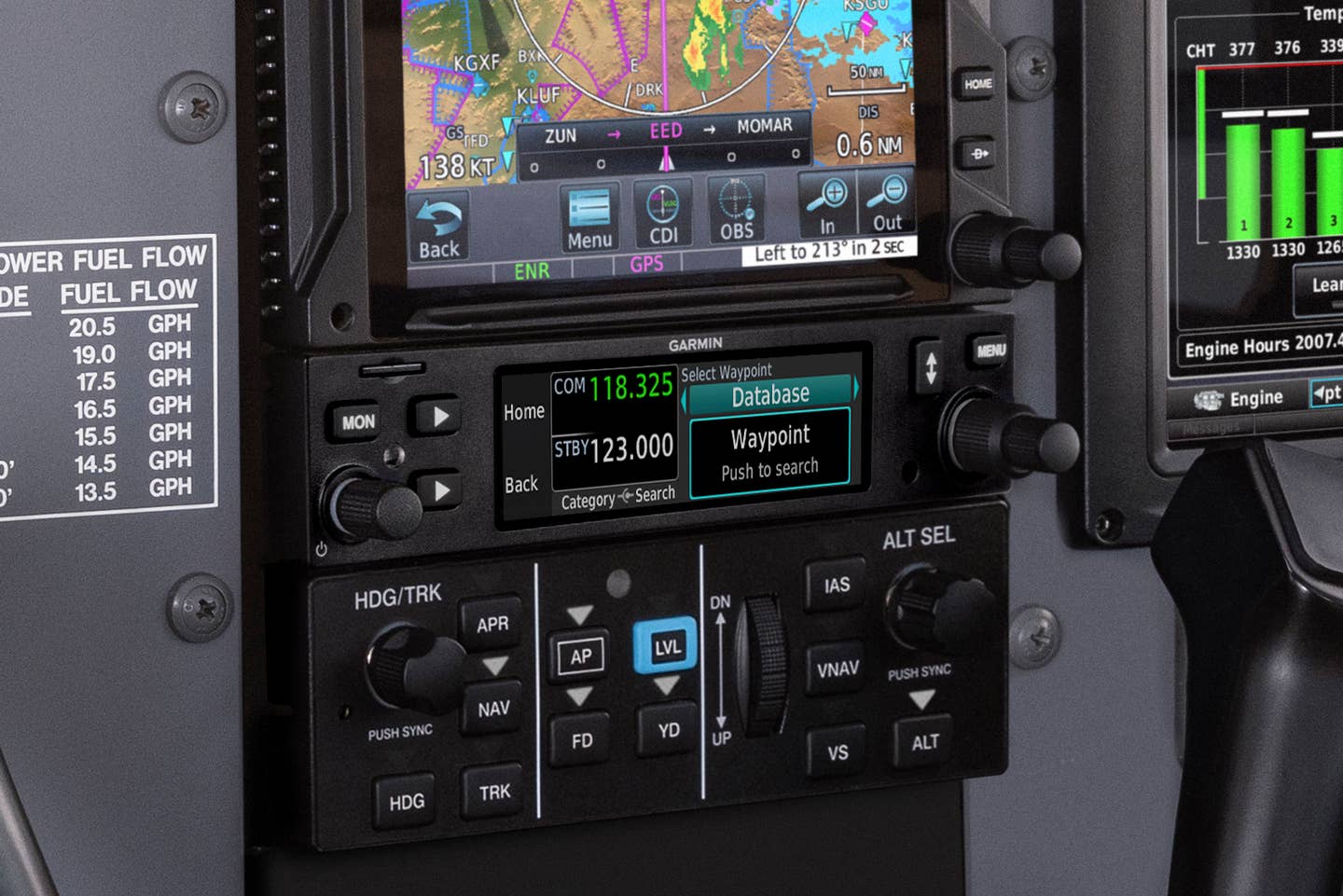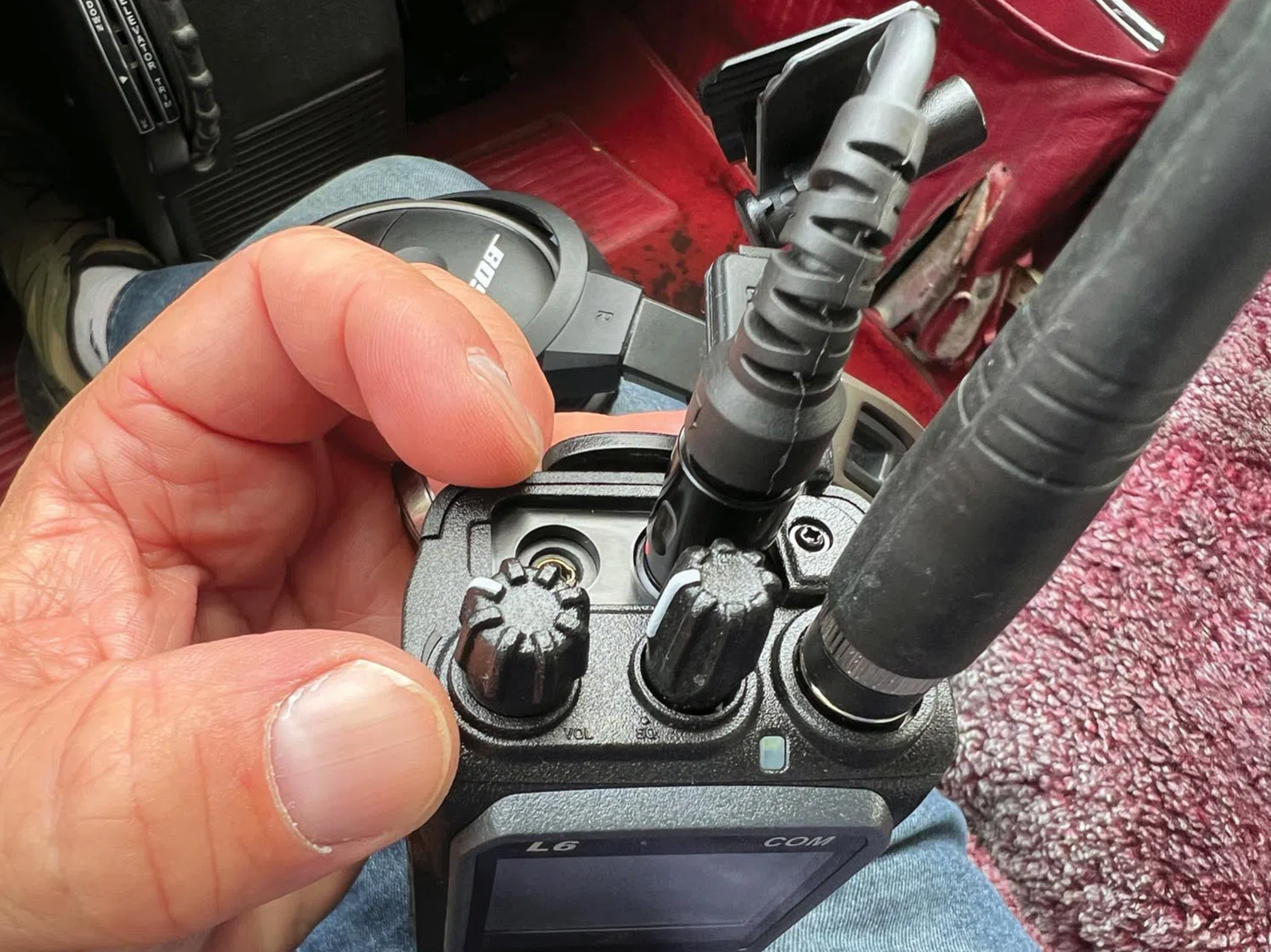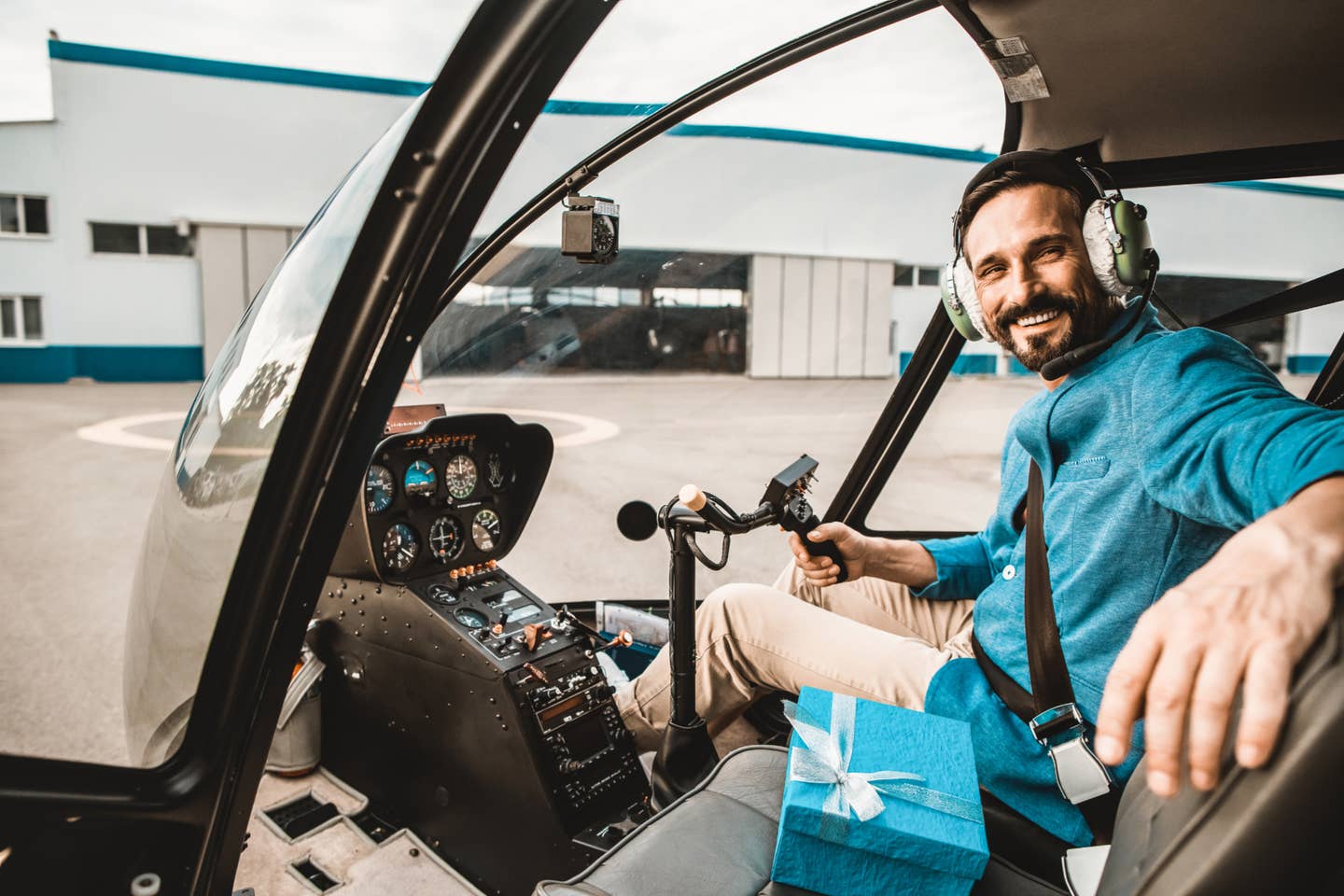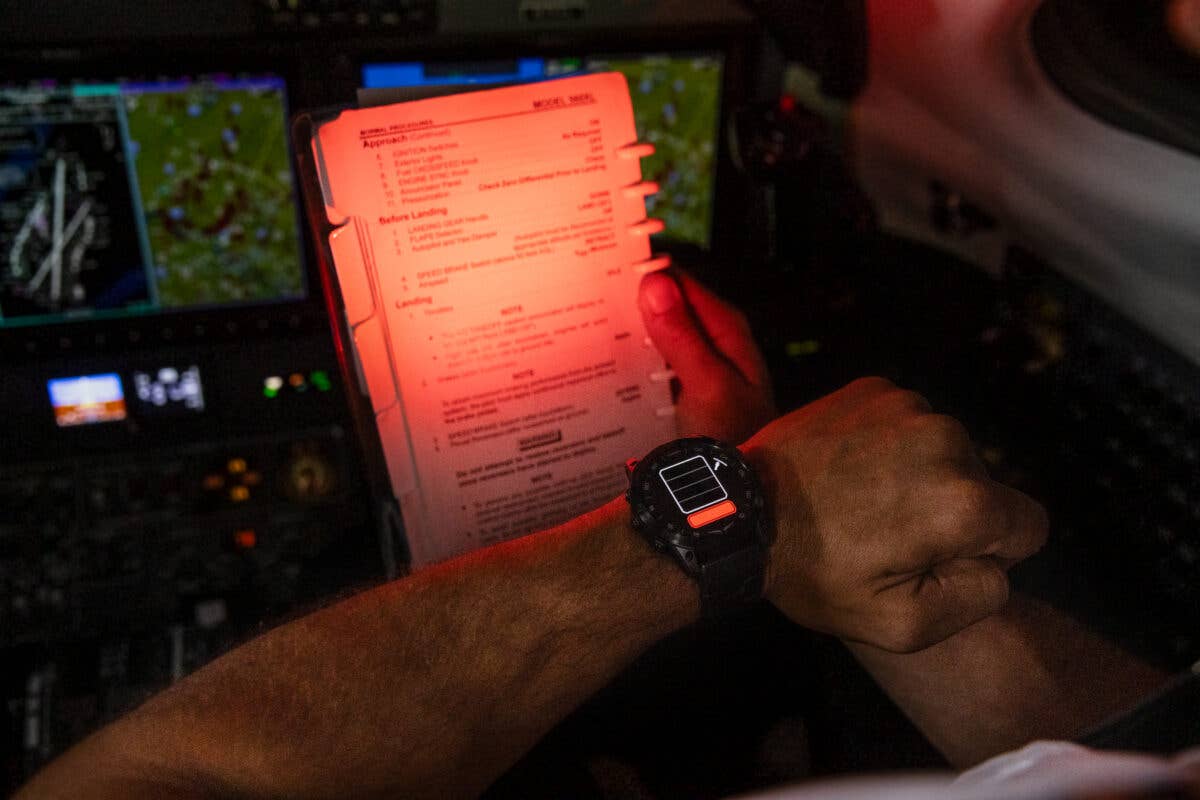Brimstone Laptop Fire Containment Bag
These days, nobody leaves their personal electronic devices at home. While uncommon, the lithium-ion batteries powering many devices have been known to catch fire. The Brimstone Laptop Fire Containment Bag ($595) provides protection in case that happens in the cockpit. Just put the overheating device into the bag and seal it shut.
The heavy-duty containment bag is multi-layered, including a carbon layer that will withstand up to 3,000 degrees Fahrenheit and a Kevlar layer to protect against shrapnel in the event of a battery explosion. The bag comes with a set of gloves for handling a hot device. Each bag has an individual serial number to help keep track of recommended yearly maintenance inspections.
Brimstone Fire Containment Bags are made of FAA-certified materials. The bags are intended for single use, but the company will replace a bag used to contain a fire for free. The laptop bag measures 4" x 17" x 2" and weighs 29 ounces. Smaller sizes are available for tablets and cell phones.
Learn more at Sporty's Pilot Shop.
PropLock
If you're looking for a little additional security for your aircraft, PropLock ($280) might be the tool to put your mind at ease. PropLock is as simple to use as a traditional bike chain. The steel wire rope---coated to prevent scratching---wraps around the propeller blades and locks into place.
The PropLock works on just about any airplane, single- or multi-engine, with a propeller. The nickel-plated lock assembly locks and releases with a key. The device comes with its own carry-pouch, which doubles as a Remove Before Flight sign. The bright red PVC coating on the wire makes it easy to see, to help prevent attempts to start the engine with it still installed. The PropLock is made of rust-proof hardened steel.
Learn more at Aircraft Spruce.
Shoes Just To Fly In?
We try out Lift Aviation's pilot-specific shoes and see if they make sense.
Lift Aviation recently launched a lineup of aviation-specific shoes engineered especially for piloting. We tried out the top-of-the-line Dakota model in the airplane and came away with an answer to the question, why would anyone need an aviation-specific shoe?
The idea of a shoe specially made for flying probably sounds strange to most of you. After all, we've all been wearing our regular footwear for flying for many decades, so why would we need an aviation shoe now? As it turns out, aviation is an outlier in not having specific shoes associated with the activity. It actually wasn't until I started working on this story that I thought much about it. I've got activity-specific shoes for running, hiking, rock climbing, riding horses, riding motorcycles and playing tennis. Aviation is the exception not the rule.
The folks at Lift say that it shouldn't be the outlier, and they point to high-performance automotive footwear to back up their claim. Shoes that hard-core drivers wear are overbuilt, rugged and form fitting. They also feature soles that are engineered specifically for the act of driving, so they don't catch or snag as you're down shifting going through the S-turns on the course.
Lift's aviation shoes follow that mold, but with a few interesting twists.
The Dakotas I wore feature what the company refers to as "heel sliders," a pair of hard plastic raised steps running in parallel to the sole's surface. The sliders, as the name states, slide smooth on carpeted or even rubberized surfaces, allowing the pilot to move their feet to the pedals quickly and with a minimum of resistance from the flooring. There's also a generously sized forefoot section that allows for easy, full contact with the rudder pedals for positive control. And the oil-resistant soles, like the rest of the shoe, are built extremely tough. I've worn them now for a few flights, and in the cockpit, they're clearly in their element, making everything you do with your feet as you're taxiing and flying feel positive and responsive.
The style component is pretty impressive too. The full-leather, precision stitched uppers would look at home at any event, from a Saturday hot dog roast at the airport to a business casual lunch with the work crew.
While they're attractive and really functional, they fit very snugly, by design. The idea is to have no slop in the controls, so the shoes hug your foot closely. They are also stiff by design, so walking around in these high-performance shoes feels different, firmer and a little narrower than you're probably used to.
At $189, they're a little expensive compared to some active footwear, but then again, they are good at exactly what they were designed to do, and unlike my $150 running shoes, these shoes will last a very long time and look good in the process, too.
- Isabel Goyer
Learn more at Lift Aviation.
Brightline B7 Flight Bag
If you're looking for a highly adaptable, customizable flight bag, the Brightline B7 ($204) is more-or-less four options in one. This modular bag can transform from a simple, slim case for carrying a 13" laptop and other small gear to a six-section overnight bag with a couple of stages inbetween. Converting the bag is easy---just unzip and re-zip the modules into the size and configuration you want.
The Brightline B7 features zippered storage everywhere. The front pocket cap section has 9 individual pockets for smaller gear like fuel strainers and flashlights. The 4-inch-wide center section has a removable divider shelf---good for carrying two headsets or similarly sized objects. It can also be opened along the entire length for easy access to anything stored below the divider. The divider can also be left out to make room for clothing and larger gear.
Two side pocket sections can be attached to the center section for pens, radios, or water bottles. There is also a 3-inch storage section designed for laptops and documents. The last piece of the puzzle is the rear flat cap, which has three easy-access storage pockets. The B7 is soft-sided to allow for some expansion.
Learn more at mypilotstore.com.
Revere ComfortMax Inflatable Life Vest
Carrying a life vest when making an overwater flight can be both a necessary precaution and a space-consuming hassle. The compact Revere ComfortMax Inflatable Life Vest ($89) makes it a little easier. When the string is pulled, the ComfortMax vest inflates almost instantly with an integrated CO2 cylinder. The cylinder is accessible via an exterior access flap, making it easy to replace without even needing to unfold the vest.
The ComfortMax vest has fully connected and reinforced back and waist attachment straps. It has SOLAS-Grade reflective tape panels for better visibility in the water and comes with an emergency whistle. The 3-pound vest is designed for people 16 years or older and weighing 80+ pounds. It is a USCG-Approved Type III life vest.
Learn more at Pilot Mall.
A Portable Air Conditioner: We Fly With B-Kool
For hot days in planes with no AC, can an ice chest unit make a difference?
It gets hot early in Texas, both early in the day and early in the year, so when Bob Stephens called and asked if I wanted to try out one of his B-Kool ice chest air conditioners, I was in the perfect place. I also have the perfect plane, a Cessna Skylane that was built perhaps before air conditioning was invented. Okay, I exaggerate, but the point is still true, that my plane is one of many out there for which the installation of an aftermarket AC is an option that is either not available or not financially practical. Or both.
The B-Kool is an air conditioner built on the bones of a large, not an extra-large, ice chest. The unit features a blower motor that takes the cold air that's created as the ice just barely melts and pumps it into the cockpit via a long flexible duct. The whole thing draws under 4 amps, so even an older 14-volt system, like that on my Skylane, can handle the load.
I first tested the unit on a typical Saturday morning flight with a friend heading out to Fredericksburg, Texas, for a bite at the world-famous Airport Diner, a cool 1950s-style spot that's a busy place on a nice weekend morning. Well, it was nice for the most part on the day we went flying. It was mostly sunny, though with a broken layer just above us!filing IFR to go 60 miles for breakfast was something we could have done, but the layer was uniform and there was plenty of room for VFR under it, with lots to spare. The downside was, it was hot.
I'd already put the cooler in the otherwise empty back seat of the Skylane and buckled it in, which you want to do anytime you have anything heavier than a pillow in back. The unit takes up a little room, but it would still be easy to get a passenger in back on one side with the cooler on the other. I got a couple of eight-pound bags of ice from the friendly folks at Skyport in San Marcos, where my Skylane lives, and emptied it into the chest. I then added, as Bob said I should, a large cupful of water. Too little and it won't get as cold and too much and it won't, you guessed it, get as cold.
We took off and after we leveled off at 2,500 feet, I clicked the remote controller on my plane's key fob and the B-Kool came to life. It's quiet enough that we couldn't hear it with the O-470 humming away, but my flying buddy immediately turned around, looked at the cooler, looked at me and said something to the effect of, "Wow, that thing actually works." It did. It worked great, too. It has its limits. It's best to keep you cool as you get ready to go flying, as you climb, and as you descend. Once you get up to altitude, typically you won't need it, as Mother Nature provides naturally cooler air as you climb. But since we were flying low, we did need it, and it came through, blowing a much appreciated strong stream of very cool air into the front of the plane, making a too warm and too bumpy flight much more comfortable.
After breakfast we climbed back in---some folks attach a little motorcycle-style battery to the B-Kool so they can run it before they climb in. I waited, again, until we'd leveled off on our way home, and the B-Kool kept on doing its thing. In fact, by the time we got back to San Marcos and I emptied the cooler out, there was still a lot of ice, which means a lot of cooling capacity, left.
The B-Kool goes for $299 and is available in either 12- or 24-volt versions. It's available at just about every popular online pilot supply shop.
- Isabel Goyer
Learn more at B-Kool.
Want to read about more cool pilot stuff? Check out last month's Gear now.

Subscribe to Our Newsletter
Get the latest Plane & Pilot Magazine stories delivered directly to your inbox





